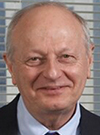Klinzing Revisits Ecuador, Witnesses the Future
When George Klinzing first visited Central University of Ecuador, the Pitt faculty member had recently earned a PhD in chemical engineering from Carnegie Mellon University. It was 1963, and for the next few years, he lived and worked in Quito, Ecuador, as part of a delegation of 14 Pitt faculty members representing disciplines ranging from history to physics. Their mission, funded by the U.S. Agency for International Development (USAID), was to assist Central University in its development. In this role, Klinzing helped modernize the chemical engineering laboratories and curriculum and strengthened the university’s library collection. He also taught students, after completing an intensive, month-long course in Spanish.
 At the time, Central University was an institution of modest means, Klinzing recalls. The school’s instructors were all part-time, and many would teach classes at 7 a.m. before heading to work, then return in the evening to teach again. Students learned chemical engineering by watching instructor demonstrations, not by conducting their own experiments, because the school lacked laboratory space and equipment.
At the time, Central University was an institution of modest means, Klinzing recalls. The school’s instructors were all part-time, and many would teach classes at 7 a.m. before heading to work, then return in the evening to teach again. Students learned chemical engineering by watching instructor demonstrations, not by conducting their own experiments, because the school lacked laboratory space and equipment.
Much has changed in the five decades since Klinzing was part of the USAID project. Today, Central University is among the top-ranked universities in Ecuador. And, at Pitt, Klinzing is now the Whiteford Energy Professor and professor of chemical and petroleum engineering in the Swanson School of Engineering.
In fall 2015, Klinzing was invited to return to the Ecuadorian university for a very special occasion—an homenaje, or homage, celebration to honor his more than 50-year relationship with Central University. During his return visit, he was awarded several citations and commemorative medals and named a Lifetime Professor of Central University.
The differences he witnessed during his 2015 return to the South American capital city were “absolutely amazing,” says Klinzing. “The change was dramatic. Lots more buildings have gone up on the campus, and throughout the city, there are high-rises popping up everywhere.” The suburban neighborhood where Klinzing lived as a young faculty member, once marked by small colonial-style houses, is now crowded with tall buildings.
Klinzing was deeply impressed, too, by what he found at the university, with its skilled, full-time faculty and state-of-the-art equipment. During the 2015 visit, Klinzing gave several well-attended lectures in Spanish, a language in which he has remained fluent. Along with discussion about his own current research, he also described his work in the 1960s, illustrating his remarks with photographs of Central University during that time, delighting his audiences. And he was particularly pleased to find that the university’s Department of Chemical Engineering uses many of the same experiments that he assigns to students in his own classes at Pitt—evidence that his work modernizing Central University’s curriculum has had a lasting impact.
The Ecuadorian university wasn’t the only institution to benefit from the 1960s exchange. The program was one of the first international initiatives launched via Pitt and represents the beginning of the University of Pittsburgh’s now robust international focus. After his return to the Pitt campus in 1967, Klinzing’s ongoing connections to Central University resulted in a number of Ecuadorian students pursuing advanced degrees, some at Pitt.
In turn, the exchange program also left a lasting impact on Klinzing’s career. The experience of helping to modernize Central University informed Klinzing’s future work at Pitt, particularly in his role as vice provost for research from 1995-2013, which focused on fostering an environment of collaboration, support, and encouragement for research faculty, staff, and students; visiting federal-funding agency officials with Pitt faculty; guiding researchers in their innovation and commercialization efforts; and overseeing policy initiatives aimed at collaboration among Pitt researchers, industry, and government.
There was another specific and lasting outcome, too. The Swanson School of Engineering’s home, Benedum Hall, was planned and constructed in the years following Klinzing’s return from Ecuador—and he had a role in equipping the building and advancing progress there.
“I knew exactly where to buy equipment, and how to fix it,” Klinzing says. “And I knew how to set up a lab. I felt I had a foot-up on things.”
Other Stories From This Issue
On the Freedom Road

Follow a group of Pitt students on the Returning to the Roots of Civil Rights bus tour, a nine-day, 2,300-mile journey crisscrossing five states.
Day 1: The Awakening
Day 2: Deep Impressions
Day 3: Music, Montgomery, and More
Day 4: Looking Back, Looking Forward
Day 5: Learning to Remember
Day 6: The Mountaintop
Day 7: Slavery and Beyond
Day 8: Lessons to Bring Home
Day 9: Final Lessons

